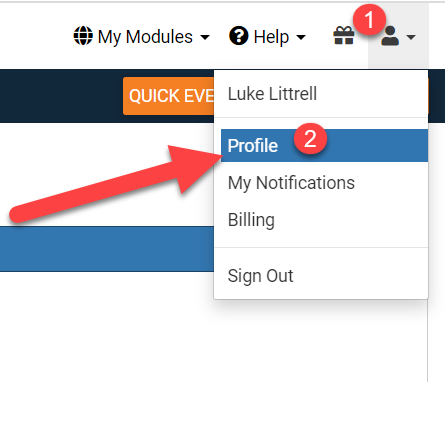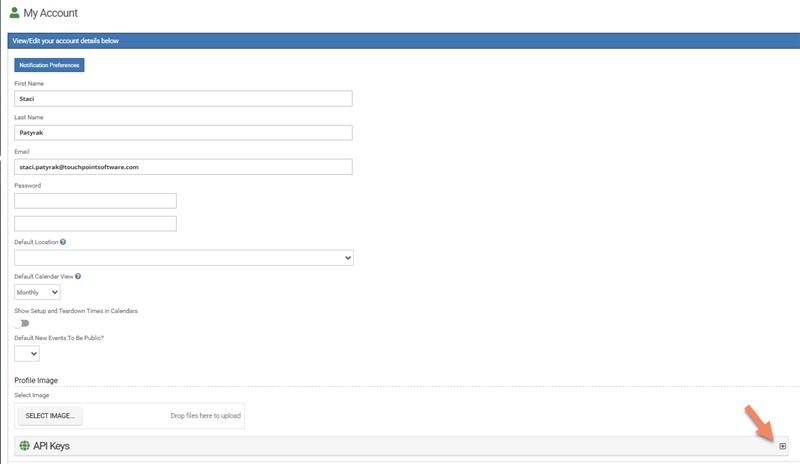Bellevue Baptist Church in Memphis, Tennessee, has always had a mission-driven heart, focused on reaching people with the Gospel and equipping them for discipleship. As one of the largest churches in the country, Bellevue Baptist recognized early on that effective ministry requires powerful, adaptable tools—ones that not only streamline church operations but also enhance engagement, volunteer management, and ministry impact.
What began as an internal need at Bellevue led to the development and release in 2007 of Bellevue Church Management System (BVCMS), a people-centric platform designed for discipleship and ministry tracking. Over the years, this system evolved into what is now known as TouchPoint Software, a robust church management platform that continues to serve Bellevue Baptist and hundreds of other large churches nationwide.
Bellevue’s relationship with TouchPoint is more than just a software solution—it is a ministry partnership that has grown and evolved to meet the church’s changing needs. Through different seasons of leadership, innovation, and improvement, TouchPoint remains at the heart of Bellevue’s operations, ensuring that no person, volunteer, or ministry opportunity falls through the cracks.

The Birth Of TouchPoint: A System Built By The Church, For The Church
In the early 2000s, Bellevue Baptist was growing rapidly, with thousands of members actively engaged in ministries, events, and discipleship programs. However, their existing church management system was outdated, cumbersome, and lacked the flexibility and unity needed to support a dynamic, large-scale ministry.
After evaluating various out-of-the-box solutions, Bellevue’s leaders realized that no existing platform fully met their needs. Instead of settling for a system that required expensive recurring costs and workarounds, they took matters into their own hands.
With the help of David Carroll, a Bellevue Baptist member with software development expertise, the church built its own database—one that would be intuitive, accessible from anywhere, and adaptable to new technologies.
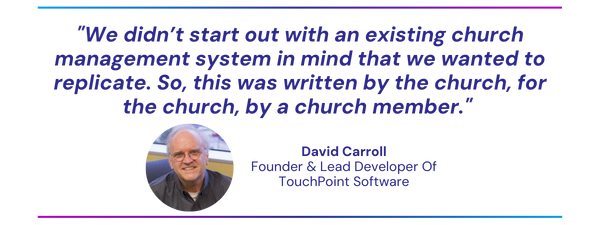
This system, originally called BVCMS, quickly transformed Bellevue’s internal processes. Ministry departments took ownership of their own data, reducing the need for a department of staff dedicated to data entry. Lay leaders were empowered with limited access to member data, allowing them to take more direct responsibility in shepherding their groups.
“It’s a different way of doing church management,” said Karen Worrell, Bellevue’s Systems Administrator at the time. “TouchPoint allows staff and lay leaders to do ministry on the go. Your minister can take his phone, go to the hospital, find somebody on the app, look at their picture, see their family members, and be prepared to walk into that hospital room.”
BVCMS became an indispensable ministry tool, so much so that other churches began asking to use it. In 2015, the system renamed as—TouchPoint Software—and has partnered with some of the largest churches nationwide since.
A Season Of Development: Expanding TouchPoint’s Capabilities
With a new name, TouchPoint entered a season of accelerated development, adding new features that strengthened its role as a ministry-driven platform.
Bellevue played a crucial role in shaping the system’s evolution. Their feedback and requests directly influenced new tools, allowing TouchPoint to remain responsive to real-world church needs.
“I’ve seen a lot of changes in TouchPoint that have been for the better, especially in the last couple of years,” said Nathan Barley, Bellevue’s Minister of Church Data. “Every month, new features come out, and I keep saying, ‘That’s cool. That’s going to be good.’ It’s very impressive and exciting to see the direction the development team is taking.”
During this season, Bellevue leveraged TouchPoint for major church functions, including:
- Volunteer Management: Tracking volunteer engagement, ensuring background checks were up to date, and automating onboarding.
- Event Management: TouchPoint developed an in-database ticketing system, reducing significant costs for Bellevue’s large-scale events like their annual Singing Christmas Tree production. This also allows them to keep their data in-house and available for future use.

- Targeted Communication: With features like mass-texting and segmentation, Bellevue moved away from generic, one-size-fits-all email blasts, instead reaching the right people with the right message at the right time.
Additionally, TouchPoint’s development team has been highly responsive to feedback, rolling out updates that directly impact Bellevue’s day-to-day operations.
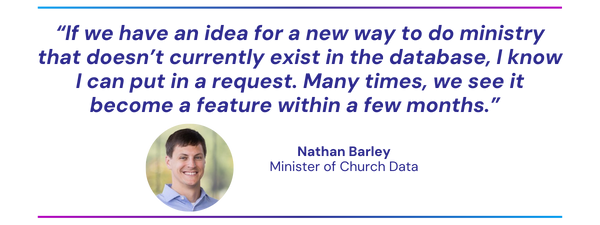
This period of growth cemented TouchPoint as a system that wasn’t just about administration—it was about ministry enablement.
A Season Of Improvement: Streamlining Ministry
While TouchPoint has always been an evolving platform, the current leadership has ushered in a new phase focused on efficiency, user experience, and partner-driven improvements.
Nathan Barley has seen firsthand how the small, yet powerful refinements TouchPoint is making are transforming Bellevue’s workflow:
“TouchPoint’s focus on reducing clicks and fixing functionality is really encouraging,” he shared. “Everything is just becoming more streamlined, and that makes a huge difference when you’re managing a church this size.”
One of the biggest areas of improvement has been automation. TouchPoint has enhanced features like Process Builder, allowing Bellevue to automate steps in volunteer onboarding, membership tracking, and discipleship pathways.
“The status flag system is one of the best tools for quick visibility on volunteer eligibility,” Nathan explained. “The rings on profile pictures—blue for background checks, magenta for MinistrySafe training—are a simple and clear way to assess a person’s readiness to serve.”
TouchPoint’s ability to adapt to ministry needs in real-time ensures that Bellevue—and all its partner churches—are always equipped with the best tools for engaging, discipling, and mobilizing their congregations.
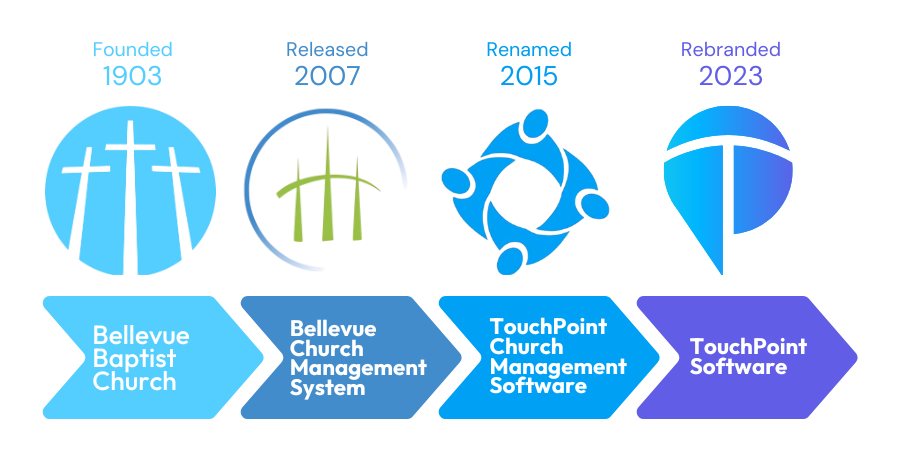
A Partnership Rooted In Shared Mission
What makes the relationship between Bellevue and TouchPoint so unique is that it’s not just a vendor-client relationship—it’s a true partnership.
Bellevue’s influence on the software continues to shape its future, ensuring that TouchPoint remains a system built by the church, for the church. The partnership is a testament to how church technology, when created with ministry in mind, can empower churches to serve, disciple, and engage their communities more effectively.
Senior Pastor Dr. Steve Gaines summarized it best:

As Bellevue continues to serve Memphis and beyond, TouchPoint Software will be there—powering ministry, strengthening connections, and growing alongside the church in its mission to make disciples.
Looking Ahead
The future of Bellevue Baptist and TouchPoint remains intertwined, with both organizations committed to innovation, improvement, and ministry effectiveness.
As churches grow and evolve, TouchPoint will continue to do what it has always done—listen, adapt, and provide churches with the best tools to fulfill their mission.
Bellevue’s journey is proof that when church technology and ministry align, the results are transformational.
At TouchPoint, we’re committed to making sure our church partners have the best tools to support their ministries. As part of this commitment, we want to let you know about an important update if your church uses the eSPACE integration. With our release tonight (March 10, 2025), there’s a small action needed on your end to ensure everything continues running smoothly.
eSPACE has informed us that their current API (v1) will be sunsetting in 2025, so we’ve updated TouchPoint to support the new Version 2 (v2), which uses JWT (Java Web Token). To complete the transition, you’ll need to take a few steps both in eSPACE and TouchPoint.
What You Need to Do:
✅ In eSPACE – You’ll need to generate a new API key. Here’s how:
An admin can navigate to their Profile by either:
Using the left-side navigation bar, OR
Clicking the person icon in the top-right corner of the dashboard and selecting Profile from the dropdown menu.
Scroll to the bottom and expand API Keys.
Once you have read the information on API Keys, choose Create New Key.
After clicking Create New Key, you can:
- Copy the new key and store it somewhere secure.
- Enter a description (e.g., a name for the key that makes sense to you, like “HR” or “Website”).
- Click Save | ⚠️ Important: You will no longer be able to see the full key after saving, so be sure to copy it first!
You can create as many API keys as needed. We recommend creating one for each system that requires API access, ensuring the same level of access as your login.
✅ In TouchPoint – Once you’ve generated your API Key in eSPACE, there is just one quick step in TouchPoint:
- Go to Admin > Advanced > Settings > Integrations > eSPACE.
- Locate the new eSPACE API Key field.
- Copy and paste your new API Key into this setting.
That’s it—you’re all set! 🎉
We appreciate your help in making this transition smooth. If you have any questions or need assistance, feel free to reach out.
Ensure A Smooth Easter With Effective Volunteer Coordination
Easter is one of the most significant days on the church calendar. It’s a time when attendance surges, new guests walk through your doors, and your congregation comes together to celebrate the resurrection of Christ. To create a welcoming, organized, and impactful Holy Week & Easter services, churches rely heavily on volunteers.
Yet, effective volunteer coordination can be a daunting challenge. Between planning, recruiting, scheduling, communicating, and appreciating your volunteers, church leaders often find themselves overwhelmed. A well-structured volunteer coordination strategy can make all the difference.
This guide will provide church leaders with practical steps to streamline volunteer coordination, ensuring Easter runs smoothly while fostering a culture of service and discipleship.
1. Plan Early And Strategically
A strong volunteer effort starts with clear planning. Easter services usually require a higher number of volunteers than a typical Sunday, so outlining roles and responsibilities well in advance is crucial.
Steps To Effective Volunteer Planning:
- Meet With Ministries: Schedule time with each of your ministry areas to compile their requests for the Easter season.
- Assess Your Needs: Take inventory of all the roles that need to be filled (greeters, parking attendants, children’s ministry, hospitality, tech support, etc.).
- Build a Leadership Team: Assign key volunteers or staff to oversee different ministry areas to alleviate administrative burden.
- Define Expectations: Each role should have a clear job description, including responsibilities and time commitments.
- Create a Process: Utilize a system that allows for easy volunteer signups, tracking, and follow-up with potential volunteers.

2. Recruit With Vision And Purpose
Recruiting volunteers isn’t just about filling slots; it’s about inviting people into meaningful ministry. Casting vision for why volunteers are needed and how their service impacts the Kingdom of God is key.
Best Practices for Volunteer Recruitment:
- Make a Church-Wide Appeal: Announce the need for volunteers during services, in bulletins, and on social media. The most effective way to get buy-in is a call to action from your Senior Pastor during services.
- Leverage Personal Invitations: People are more likely to serve when personally asked by a pastor, staff member, or fellow churchgoer.
- Highlight the Impact: Share stories of how volunteering has blessed both the volunteer and those they serve. A testimonial video to show during service can inspire people to join a serve team.
- Use an Easy Sign-Up Process: A simple online registration system makes it easier for volunteers to commit. Create a QR code that be used across multiple mediums (sanctuary screen, church bulletin, social media, etc.) to reduce friction in the signup process.

3. Schedule With Flexibility And Clarity
Managing schedules can be one of the most complex aspects of volunteer coordination, especially when dealing with last-minute changes.
Tips For Creating A Smooth Volunteer Schedule:
- Use a Centralized System: A volunteer scheduling tool can automate sign-ups, send reminders, and prevent double bookings. This is the time to reduce data silos and have your whole staff implement the same system so that everyone is on the same page.
- Offer Multiple Serving Times: Some volunteers may not be available on Easter Sunday but can help during the week leading up to it. Examples may include: setup and teardown team, a landscaping team, or additional administrative support before and after Easter to help lighten the load.
- Pair Experienced Volunteers with Newcomers: This ensures new volunteers feel supported and learn from those with experience. Something as simple as having premade nametags, lanyards, or your church’s branded “serve” shirt for your team shows appreciation for their service.
- Have a Backup Plan: Prepare a list of ‘on-call’ volunteers to fill last-minute gaps. Make a request for your congregation to be willing to serve in any area as a floater. (Remember to verify that background checks are in good standing).
4. Communicate Clearly And Often
A well-organized volunteer team relies on consistent communication. Keeping volunteers informed and encouraged helps them stay committed and confident in their roles.
Effective Volunteer Communication Strategies:
- Send Automated Reminders: Use text, email, or app-based notifications to remind volunteers of their upcoming service times.
- Provide Training Materials: Share video tutorials, PDFs, or brief in-person orientations to equip volunteers with the knowledge they need to be successful.
- Encourage Two-Way Communication: Allow volunteers to ask questions and provide feedback by giving them the appropriate contact information (email, phone, text). You can also utilize your church management system for concise and consistent messaging.
- Host a Final Check-In: A pre-Easter huddle ensures everyone is aligned and prepared. Where should volunteers park? How early should they get there? All this should be clearly discussed to make sure that everyone is on the page and ready to serve your guests.

5. Show Appreciation And Foster Long-Term Engagement
Volunteers who feel valued are more likely to continue serving beyond Easter. Expressing gratitude and celebrating their contributions builds a culture of service within your church.
Ideas for Showing Volunteer Appreciation:
- Send Personalized Thank-You Notes: A handwritten note or email from church leadership goes a long way.
- Host a Post-Easter Celebration: Gather volunteers for a special meal or reception to celebrate their efforts. Give out fun and creative awards to those volunteers that went above and beyond.
- Publicly Acknowledge Volunteers: Recognize their commitment to the Kingdom with a Volunteer Spotlight on social media. This not only shows how much you love and value them but also helps your congregation continue to get to know each other by name and image.
- Provide Small Gifts or Incentives: Consider offering a small token of appreciation such as a devotional book or church-branded merchandise.

Elevate Your Processes & Celebrate Easter!
Easter is a prime opportunity to welcome guests, engage your congregation, and ultimately share the Gospel with more people. Volunteers play an essential role in making this possible. Through the implementation of a well-thought-out volunteer coordination strategy, churches can ensure that both volunteers and attendees have a meaningful experience.
By focusing on planning, recruiting, scheduling, communication, and appreciation, church leaders can create an environment where volunteers feel empowered and eager to serve—not just for Easter but for years to come.
With the right tools and a heart for ministry, your church can elevate its volunteer coordination efforts, leading to a more effective and impactful Easter celebration.
Upgrade Your Church Software For A Streamlined Volunteer Experience
Feeling overwhelmed or lacking the right tools to implement these strategies effectively? It may be time to evaluate your church management software. TouchPoint’s Scheduler is designed with discipleship in mind, helping churches eliminate data silos, streamlining communication, and elevating volunteer coordination. Schedule a free demo today and discover how we partner with some of the largest churches in the country to enhance volunteer management!
As church leaders, you know that tracking engagement is key to fostering discipleship growth and ensuring no one slips through the cracks. But how can you effectively measure engagement across attendance, giving, volunteering, and other factors? In our recent webinar, Andrew Triplett, Head of Consulting at TouchPoint Software, walked us through Engagement Insights, a powerful tool for understanding the health of your congregation.
Key Takeaways From The Webinar
What Are Engagement Insights?
Engagement Insights provide a data-driven approach to measuring church involvement and discipleship. Rather than relying on assumptions, churches can track key behaviors—such as attendance, serving, and giving—to better understand trends and respond proactively with ministry.
The Five Engagement Buckets
To get a full picture of engagement, Andrew introduced five key areas:
- Membership – Who identifies as a part of your church?
- Attendance – How often do they attend services and events?
- Giving – Are they financially committed to your mission?
- Volunteering – Are they actively serving in ministry?
- Enrollments – Are they involved in life groups, Bible studies, or other church programs?
How To Use Engagement Insights To Strengthen Ministry
By setting up Engagement Insights in TouchPoint Software, churches can:
- Identify trends in engagement over time
- Spot early warning signs when someone disengages
- Use data to create personalized outreach lists
- Equip ministry teams with actionable insights to foster deeper connections
Watch The Full Webinar
If you missed the live session, you can watch below for the full webinar recap.
Looking for help setting up Engagement Insights for your church? Contact our team at [email protected] for expert guidance.
Another article you might like: Church Engagement Can Be Easy And Intentional!
How Volunteers Can Use TouchPoint
To effectively manage their groups, volunteers need access to specific features of TouchPoint’s church management database. Here’s how they can do so efficiently:
- Accessing the Database
- Volunteers log in using their credentials.
- Then, they navigate to their profile and select the Involvements Tab to view their groups.
- Viewing Group Information
- If they are a member of a group, they can see basic information.
- If they are a leader, they gain additional access to group details and member profiles.
- Managing Group Members
- Leaders may view member profiles (depending on settings).
- Additionally, they can track attendance and view reports such as the ‘Recent Absence Report’ to follow up with missing members.
- Communication & Reports
- Volunteers can send emails or texts to group members directly through TouchPoint.
- Moreover, they can generate reports using built-in tools to track engagement and participation.
By utilizing these features, volunteers and lay leaders can effectively manage their responsibilities while maintaining appropriate data security.
Why Volunteer Empowerment Matters
As Easter approaches, churches have a unique opportunity to rely more on their dedicated volunteers and lay leaders. These individuals are the backbone of a thriving church community, helping to create welcoming and organized worship experiences. By equipping them with the right tools and resources, pastors and church staff can focus more on spiritual leadership while ensuring that every aspect of church life runs smoothly. Ultimately, a well-prepared volunteer team enhances the church’s ability to minister effectively, making Easter services and events more impactful for everyone involved.
Churches thrive on community, and strong volunteer leadership fosters a sense of belonging and shared mission. Therefore, investing in your volunteers and lay leaders is crucial for several reasons:
- Easing the Burden on Church Staff: Pastors, church admins, and staff members often wear many hats, from pastoral care to event planning. Consequently, delegating responsibilities to well-trained volunteers allows staff to focus on spiritual leadership and vision casting.
- Enhancing Church Management and Organization: A church management database, such as TouchPoint, helps keep track of member involvement, attendance, and group activities. By granting volunteers the appropriate access—such as tracking group attendance or communicating with members—churches can ensure smooth operations while maintaining necessary restrictions on sensitive data.
- Improving Congregation Engagement and Care: Volunteers can keep track of attendance trends and identify members who may need follow-up or encouragement. For example, a ‘recent absence’ report allows leaders to reach out to those who have missed multiple small groups or reoccurring events, thereby strengthening pastoral care efforts.
- Fostering Leadership Growth Within the Church: By equipping volunteers with skills and responsibility, churches cultivate future ministry leaders. When volunteers feel trusted and prepared, they are more likely to take on greater roles in the church’s mission.
Equipping Volunteers With The Right Tools
A great church management system provides different levels of access, ensuring that volunteers and lay leaders have what they need without compromising church security. Fortunately, TouchPoint allows for completely customized access, creating flexibility for:
- Group Leaders: Leaders can view and manage their group’s attendance, send communications, and pull relevant reports.
- Church Admins & Pastors: Staff may maintain oversight while delegating day-to-day group management to trusted volunteers.
- General Members: Churchgoers have limited access to view their own involvement and family members’ details but cannot modify church-wide information.
Start Preparing Now For Easter
Easter is a perfect opportunity to train and empower your volunteers. As services grow in attendance, so do logistical needs. Thus, usher teams, children’s ministry volunteers, small group leaders, and hospitality teams all play crucial roles in creating a welcoming church environment.
To get started, consider the following steps:
- Identify and train key volunteers and lay leaders.
- Provide access to TouchPoint’s church database with clear guidelines.
- Encourage ongoing communication between staff and volunteers.
- Run test events or small projects to practice delegation.
By investing in your volunteers today, you ensure a smoother, more impactful Easter season—and ultimately build a stronger church community for the future.
Building A Stronger Church Community
Church leadership is a shared journey that thrives when the entire body of Christ is engaged. By equipping volunteers and lay leaders with the right tools, responsibilities, and support, you create a strong and vibrant church community. As Easter approaches, this is a wonderful opportunity to invest in your volunteers, ensuring they feel empowered to help welcome and minister to everyone who walks through your doors.
TouchPoint Consulting Team
Need support setting volunteer access? Our TouchPoint Consulting Team is available to assist with church database configuration and Check-In setup. You can email our team at [email protected].
For additional ways to enhance your Easter experience, check out our other TouchPointers and blogs!





